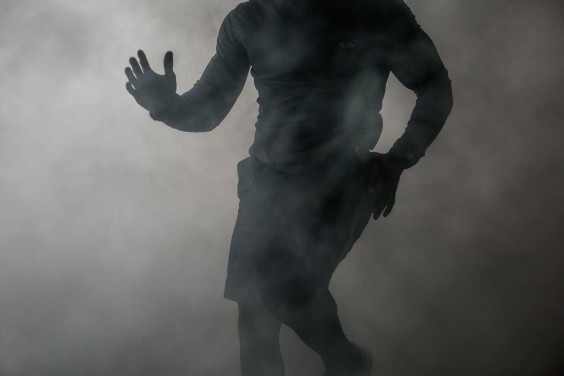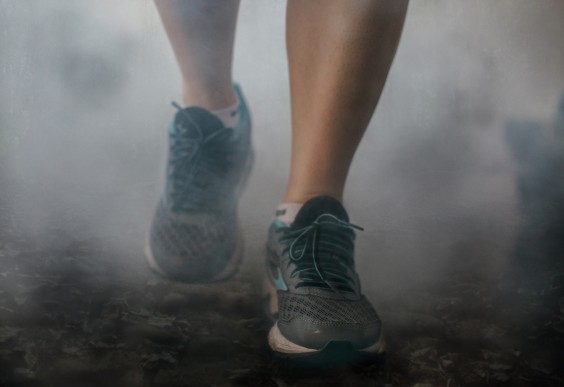[dropcap]I[/dropcap]t’s a typical Wednesday evening. After a long run, Andrew*, who works in digital media in New York City, is following his standard post-run routine. Like most runners, he’ll quickly cool down, stretch, drink water, and maybe grab a post-workout snack. Unlike many runners, he’ll also smoke pot.
The avid runner and cyclist, whose racing résumé includes the Umstead 100 Ultra, typically lights up immediately before his athletic activities and usually within an hour or two post-sweat session.
Andrew isn’t alone in his habit—in fact, combining cannabis and sport has become an underground trend in distance-running culture. Ultra runners such as Avery Collins and Jen Shelton have admitted to running under the influence of marijuana. And former professional runner Chris Barnicle, a cannabis advocate living in Los Angeles, calls himself the “world’s fastest stoner” on Twitter. Pro-cannabis running groups, like Run on Grass in Denver, are dedicated to staying fit and educating others about cannabis, while online communities like Cannafit and NORML Athletics also promote cannabis’ association with healthy living.
And it’s not just runners who are experimenting with weed. Bodybuilders may hit a bong to prevent soreness and sleep better, while action sports athletes such as mountain bikers, skiers, and snowboarders may light up on the lift to get in the zone, loosen up, or release their inhibitions. Even some athletes participating in niche sports such as skeleton, bobsledding, and ice hockey toke up.
Your Brain on Mary Jane
Andrew didn’t used to light up before a workout. “As I started getting into longer distances like marathons, I noticed my mindset was very similar when I’m running and when I’m high,” he says. “If I don’t smoke before a run, I’m constantly thinking about the miles and how much further I have to go, rather than just enjoying the experience.”
Science backs up this sensation. A quick refresher course on how weed works: When you ingest marijuana—whether via smoke, vape, or edibles—its chemical compounds, or cannabinoids, combine with your brain and body’s receptors that regulate pain, emotions, appetite, and memory. The compound called cannabidiol (CBD) is nonpsychoactive and brings about that calm and relaxed feeling. The other main compound is tetrahydrocannabinol (THC), a psychoactive chemical that generates feelings of euphoria, relaxed inhibitions, lack of focus, and sometimes drowsiness.
While weed may not sound like an ideal substance to ingest before lacing up your sneakers, it turns out our bodies naturally produce similar compounds after exercise. Research has shown high levels of anandamide, a cannabinoid naturally produced in the body, in the bloodstream of people after exercise.
So, ingesting cannabis mimics the very natural process of increasing exercise-induced endocannabinoids, says Gregory Gerdeman, an assistant professor of biology at Eckerd College. “That runner’s joy—whether natural or marijuana induced—can minimize distraction and help exercise be not just a means to an end but an enjoyment.”
The Perks of Pot
In a competitive world, it’s not unusual for runners to go beyond the basics to enhance their performance, whether it’s wearing compression gear, plunging into ice baths, or even downing pickle juice during a race (seriously, it’s a thing). But can using cannabis really give them an edge?
Studies on the effects of cannabis on athletes are very limited—and the studies that are available tend to focus on the negative effects, says Amanda Feilding, director of The Beckley Foundation, a nonprofit in the U.K. devoted to consciousness and drug policy research. But plenty of pro-cannabis advocates, as well as some studies, point out potential benefits of pairing pot and running.
These positive effects are mostly indirectly related to the sport itself, Feilding says, such as helping people relax before or after a competition. Athletes seem motivated to use cannabis due to its effects on anxiety and well-being, and its promotion of better sleep before a race. (Since it can affect your coordination, Feilding points out that it might be better to avoid cannabis immediately before a competition.)
Another perk for athletes: Cannabis can increase impulsive responses, leading to more risk-taking behavior—without affecting decision-making—which can be beneficial in competitions.
So it’s no wonder athletes are turning to marijuana more and more, especially college athletes.Synthetic Cannabinoid Use and Descriptive Norms among Collegiate Student-Athletes. Egan KL, Erausquin JT, Milroy JJ. Journal of psychoactive drugs, 2016, May.;48(3):2159-9777. A recent study shows weed has replaced tobacco as the second most widely used drug among athletes after alcohol—the main reason being to enhance performance.
Still, researchers say much more scientific research is needed to determine the performance-enhancing effects. (Translation: Don’t try this at home, kids.) Another recent study stresses the importance of developing a better understanding of the relationship between cannabis and exercise as political, cultural, and legal trends are rapidly changing.
Plus, inhaling smoke is not exactly an ideal delivery method, explains Dustin Sulak, D.O., a licensed osteopathic physician and advocate of integrative medicine. Instead runners can turn to edibles, vaporizers, or oral medicine. These alternatives won’t harm your lungs or expose you to the toxic substances in smoke (vaping in particular has been touted as the healthiest way to ingest cannabis), but they can also hit your system harder and last longer (up to 10 hours!) than smoked THC. In other words, use caution or talk to a medical professional beforehand.
Though the verdict is still out on the benefits of weed for runners, there’s plenty of anecdotal evidence from pro-ganja athletes. Tyler Hurst, a writer, runner, and cannabis enthusiast in Portland, OR, has been using cannabis regularly for about five years. He typically ingests a Squib, a small, easily stashable edible, before long weekend runs.
“It’s pretty great to run through a field, across a bridge, in a forest, or up a mountain while being hyperaware of your environment,” Hurst says. “I’ve recovered faster in the past year than I ever have before, all while running longer and eating the same.” He says cannabis helps relax his muscles once they become fatigued, making it easier to foam roll and stretch post-run.
The Cons of Cannabis
But is it safe? Not exactly. More research is needed to fully understand the effects of cannabis, both on running and in general, Feilding says. Cannabis also increases the heart rate, so runners might reach their limits more quickly, she explains.
Then there’s what we’ll call “the stuff our parents warned us about.” Studies show consistent cannabis use can impair short-term memory, decrease alertness, lower reaction time, accelerate muscle fatigue (leading to a shorter exercise sesh), or even cause cardiovascular disease.
Finally, we’re all familiar with the fact that smoking can damage your lungs. Although smoking pot has lower risks of lung disease compared to tobacco, marijuana smoke does contain a number of carcinogens and has been associated with an increased likelihood of chronic bronchitis.Effects of marijuana smoking on the lung. Tashkin DP. Annals of the American Thoracic Society, 2014, Feb.;10(3):2325-6621.”>
And edibles aren’t a 100 percent safe bet either: “Eating cannabis can change the quality of the effects, which come on much more slowly, and edibles can vary greatly in strength, making it difficult to measure or gage how much you should take,” says Feilding. “Taken in ignorance, people often overdo it.”
Oh, and there’s that little issue about it being against the law. Medical marijuana is legal in only 25 states (and Washington, D.C.) so far, and just four states(Alaska, Colorado, Oregon, and Washington) and D.C. allow legal recreational use.
But the times they are a changin’. At least five states(Arizona, California, Maine, Massachusetts, and Nevada) will decide whether to legalize marijuana for recreational use at the polls in November 2016, while several others are also considering changing legislation.
For now, though, any athlete experimenting with marijuana cannot be an elite competitor, since cannabis is banned by the World Anti-Doping Agency.
The Debate Continues
Some athletes disagree with that classification. “I don’t think cannabis should be considered a performance-enhancing drug,” Gerdeman says. “There are aspects of cannabis that improve athlete’s focus during training, but it’s not the same as injecting hormones that increase your blood cells or stimulate muscle growth. Good nutrition is performance enhancing, but it’s natural—cannabis falls closer to that end of the spectrum.”
Unfortunately, the strict laws around cannabis make it difficult do research, Feilding says. And the cannabis that is available isn’t regulated or consistent. “It has varying amounts of CBD and THC, the product’s two major active constituents, which can have different effects on individuals,” she explains. Plus, it’s worth mentioning that the two different types of cannabis, indica and sativa, have different effects on the user (sativa is frequently described as creating the energetic high that many athletes prefer).Cannabis – from cultivar to chemovar. Hazekamp A, Fischedick JT. Drug testing and analysis, 2012, Feb.;4(7-8):1942-7611.
Gerdeman, like Feilding, believes more research is vital to understanding the pros and cons of cannabis. “Biomedical research points to a lot of potential benefits that are really too premature to go out broadcasting, but the medical marijuana industry, which is still federally illegal, is so highly unregulated that advocates cherry-pick positive stories,” Gerdeman says. “We’re just at the cusp of learning a lot more about it.”
Barnicle, the speedy stoner from L.A., just asks that everyone keep an open mind. The former track athlete kept his habit under wraps, along with other teammates, while competing for the University of Arkansas, but wishes more big-time athletes would announce their love for cannabis to increase worldwide acceptance. He’s now developing a cannabis energy bar for athletes. “Unfortunately, athletes themselves seem to be really in a secret society about it,” Barnicle says. “The whole system just needs to be changed.”
(1227)







Leave A Reply